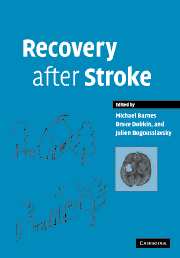Book contents
- Frontmatter
- Contents
- List of authors
- Preface
- 1 Stroke: background, epidemiology, etiology and avoiding recurrence
- 2 Principles of recovery after stroke
- 3 Regenerative ability in the central nervous system
- 4 Cerebral reorganization after sensorimotor stroke
- 5 Some personal lessons from imaging brain in recovery from stroke
- 6 Measurement in stroke: activity and quality of life
- 7 The impact of rehabilitation on stroke outcomes: what is the evidence?
- 8 Is early neurorehabilitation useful?
- 9 Community rehabilitation after stroke: is there no place like home?
- 10 Physical therapy
- 11 Abnormal movements after stroke
- 12 Spasticity and pain after stroke
- 13 Balance disorders and vertigo after stroke: assessment and rehabilitation
- 14 Management of dysphagia after stroke
- 15 Continence and stroke
- 16 Sex and relationships following stroke
- 17 Rehabilitation of visual disorders after stroke
- 18 Aphasia and dysarthria after stroke
- 19 Cognitive recovery after stroke
- 20 Stroke-related dementia
- 21 Depression and fatigue after stroke
- 22 Sleep disorders after stroke
- 23 Technology for recovery after stroke
- 24 Vocational rehabilitation
- 25 A patient's perspective
- Index
22 - Sleep disorders after stroke
Published online by Cambridge University Press: 05 August 2016
- Frontmatter
- Contents
- List of authors
- Preface
- 1 Stroke: background, epidemiology, etiology and avoiding recurrence
- 2 Principles of recovery after stroke
- 3 Regenerative ability in the central nervous system
- 4 Cerebral reorganization after sensorimotor stroke
- 5 Some personal lessons from imaging brain in recovery from stroke
- 6 Measurement in stroke: activity and quality of life
- 7 The impact of rehabilitation on stroke outcomes: what is the evidence?
- 8 Is early neurorehabilitation useful?
- 9 Community rehabilitation after stroke: is there no place like home?
- 10 Physical therapy
- 11 Abnormal movements after stroke
- 12 Spasticity and pain after stroke
- 13 Balance disorders and vertigo after stroke: assessment and rehabilitation
- 14 Management of dysphagia after stroke
- 15 Continence and stroke
- 16 Sex and relationships following stroke
- 17 Rehabilitation of visual disorders after stroke
- 18 Aphasia and dysarthria after stroke
- 19 Cognitive recovery after stroke
- 20 Stroke-related dementia
- 21 Depression and fatigue after stroke
- 22 Sleep disorders after stroke
- 23 Technology for recovery after stroke
- 24 Vocational rehabilitation
- 25 A patient's perspective
- Index
Summary
Introduction
Sleep disorders are commonly found in the general population. In stroke patients, their frequency is even higher, because brain damage can affect sleep–wake mechanisms and because cerebrovascular and sleep disorders can arise from similar predisposing factors. Sleep disorders often influence negatively general well-being, physical and mental performance, and, as a consequence, rehabilitation and final outcome. In addition, sleep-disordered breathing (SDB) – one of the most common forms of post-stroke sleep disorders – may increase the risk of stroke recurrence. For these reasons, sleep disturbances should be adequately diagnosed and treated after stroke.
Historical remarks
Changes in sleep and breathing were reported in stroke patients as early as in the beginning of the nineteenth century. Cheyne (1818) first described periodic breathing in a patient with cardiac disease and “apoplexy.” Jackson later recognized that this breathing pattern frequently accompanies bilateral hemispheric stroke (quoted by Brown and Plum, 1961). Symptoms of obstructive sleep apnea (OSA) were first reported in a patient with intracerebral hemorrhage by Broadbent (1877). In the nineteenth century, it was also already known that stroke may cause profound changes of sleep patterns. Post-stroke hypersomnia was recognized by MacNish as early as 1830 (see Lavie, 1991), but it was only in the beginning of the twentieth century that its preferential association with thalamic and mesencephalic strokes was recognized (Freund, 1913). Neurogenic insomnia (agrypnia) related to thalamomesecephalic stroke was first described by Lhermitte (1922) and van Bogaert (1926). Lhermitte (1922) coined the term peduncular hallucinosis to describe vivid, colorful, and dream-like hallucinations following midbrain stroke. Asymmetries of the electroencephalogram (EEG) during sleep, with a reduction of spindle activity over the affected hemisphere, were first reported by Cress and Gibbs (1948). During subsequent decades, other authors described abnormalities in rapid eye movement (REM) and non-REM sleep in patients with supra- and infratentorial strokes. More recently, the link between SDB and vascular disease has been suggested.
Circadian rhythms and stroke
Cerebrovascular events, such as myocardial infarction and sudden death, appear most frequently in the morning hours – between 6 a.m. and noon – and particularly within the first hour after awakening. A meta-analysis of 31 publications with 11 816 patients found a 49% increase in all types of stroke (ischemic, hemorrhagic, transient ischemic attack) during that time of the day compared with other times (Elliott, 1998).
- Type
- Chapter
- Information
- Recovery after Stroke , pp. 580 - 603Publisher: Cambridge University PressPrint publication year: 2005



